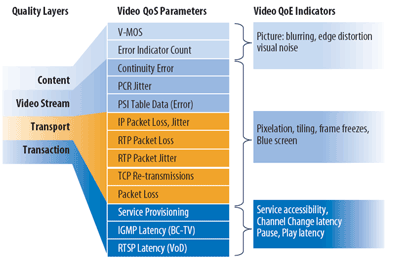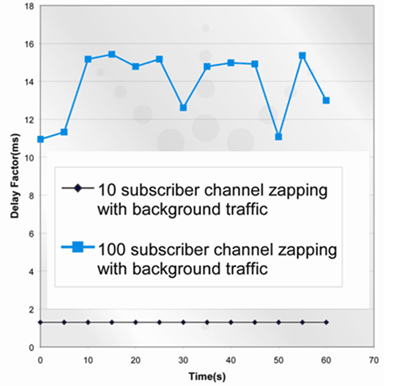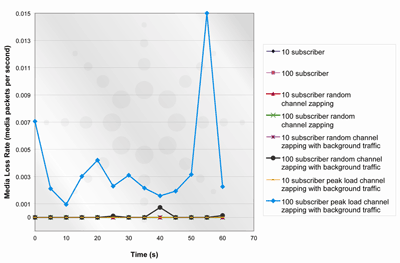Challenges delivering high QoE in IPTV networks
Customers using multiplay services are less likely to churn but, when they do, it is typically due to poor quality of experience
BY JOE HAVER
Agilent Technologies
Colorado Springs, CO
http://www.agilent.com
Advances in technology and bandwidth throughout the communications industry are fundamentally changing the way today’s networks are evolving and competing with each other. Over the past several years, traditional telephony service providers have seen shrinking revenues and customers switching to competitive offerings.
The competitive lines separating different types of network operators have virtually disappeared. Much of the growth seen in the cable and mobile industries isn’t from new users or markets, but from customers of the traditional telephony service providers. To survive, Telcos need to reinvent themselves, offering multiplay services (video/voice/data) and winning both voice and video customers to generate greater ARPU (average revenue per user) to compensate for the customers/revenue they’ve been losing.
QoE’s value
A 2005 poll of consumers that asked them to choose between a Telco and Cable TV company offering multiple services showed that 92% of consumers will chose or switch providers based on price, programming, and data rates. They do not care about the provider or technology used for delivery. Additionally, customers using multiple services are less likely to churn, but when they do, it is typically due to poor quality of experience (QoE) for any one of their bundled services. This makes getting QoE right especially critical.
Real-time multiplay services cover the full range of packet sizes and priorities and when mixed with the ever increasing demands of high-speed internet, create the quintessential perfect storm of networking. This produces significant challenges within the network to delivery high quality of service (QoS) which will in turn directly impact the overall QoE. Before diving head long into the IPTV storm, it is imperative to understand the differences between QoE and QoS.
QoE is a subjective approach used to measure how the performance of next-generation services is perceived. QoS, on the other hand, measures objective network performance, parameters, and configurations, but can be ineffective in ensuring the desired user experience.
QoS vs QoE
Channel change times, also referred to as zap times, serve as a powerful example of the differences between QoS and QoE. DSL Forum WT-126 defines thresholds for channel change times, with zap times up to 250 ms considered instantaneous, those of 1 to 2 s in the target range, and anything over 3 s unacceptable. If the distribution of network zaps measured were 250 ms, 1 s, 1,5 s, 500 ms, 250 ms, and 2 s, the QoS would seem acceptable.
But from a QoE viewpoint, consistency of the channel change times is often more important than the absolute zap time. If the channel zaps are inconsistent, the users will never become “accustomed” or know what to expect. The inconsistency results in a feeling that the service is flakey or, even worse, users may initiate double channel changes when a longer-than-expected zap time occurs.
QoE is driven not only from network QoS and delivery metrics, but includes external factors such as digital picture, cost, channel selection, guide and PVR to name a few. These have a major impact on the QoE, but are not quantifiable. However, primary QoS parameters can be mapped to QoE indicators (see Fig. 1 ).

Fig. 1. QoS parameters can be mapped to QoE Indicators.
IPTV test metrics
The most important QoS metrics to consider when testing and monitoring an IPTV service summarized in the table below can be found through basic network measurements or by polling elements.

IPTV is a disruptive technology and deployment implications are still fairly prevalent. It is critical to select test tools and methodologies capable of measuring QoE under increasing scale, and in the presence of a full and realistic multiplay traffic.
While provisioning a device or network to carry one type of multiplay traffic can be easy, problems are magnified when traffic loads and zapping processes are added. Channel zapping mixed with background traffic can significantly impact QoS metrics and ultimately the end user’s QoE (see Figs. 2 and 3 ).

Fig. 2. The random channel zapping load has a significant affect on the delay factor.

Fig. 3. Various zapping loads and traffic mixes impact the media-loss rate.
It’s easy to see the impact subscriber zapping and background traffic presents. This is due in part to the vast differences in packet sizes, priorities and processing requirements for the different types of traffic and makes realistic testing even more important.
IPTV promises new and innovative over the top applications, but, in the end, if the quality basics aren’t met, even the best new features won’t matter. With costs to acquire a new IPTV subscriber ranging in the $100’s, it is imperative that multiplay deployments be well tested, monitored, and maintained. Ensuring that the overall multiplay experience meets QoE expectations from Day One mitigates the risk of failure and chance of losing revenue from all services.
Diligent and thorough pre-deployment testing, under realistic and dynamic traffic-load and network conditions, is crucial and will have a direct impact on the network’s design and QoS. This pre-deployment testing must be coupled with a deployment solution that utilizes constant proactive monitoring and incorporates tools capable of dealing with all multiplay services simultaneously, so issues can be resolved before they impact the customers’ QoE. ■
Advertisement
Learn more about Agilent Technologies





